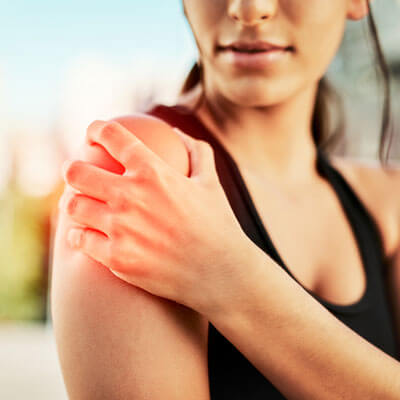Applied Kinesiology for Injury Management
 Approaching an injury using Applied Kinesiology looks very different than traditional treatments – here are some common injuries as examples:
Approaching an injury using Applied Kinesiology looks very different than traditional treatments – here are some common injuries as examples:
Ankle Sprain
Standard treatment
Rest, ice, taping. If the ligaments are totally torn then surgery to repair or a cast may be needed
AK Approach
The adage once a sprain always a sprain has been proven wrong. In a sprain of the ankle, many of the supporting ligaments, muscles, and skin become damaged. Treatment begins by assessing exactly which structures have been injured and then directing appropriate therapy to those injured structures. The second phase of therapy is to reestablish normal muscle coordination and strength. Again, there are a number of different techniques that can be used. Testing is used to prepare a specific program for your needs.
Groin Pull
Standard treatment
Rest, ice, anti-inflammatories
AK Approach
The muscles that support the pelvis are evaluated to find the ones that are malfunctioning. These are corrected and then the alignment of the pelvic bones is corrected. The attention is then shifted to the localized structures that are injured and failing to support the pelvic joints properly. These can include specialized treatments for ligaments, muscles, skin and joints. This is followed by an analysis of how the person walks, moves and their occupational positions. Finally, attention is directed to corrective procedures that can help stabilize and strengthen the structures to help prevent future injuries. Nutritional therapies aimed at increasing factors that would speed healing and reduce any inflammation are considered.
Other lifestyle modifications are used to prevent or minimize exacerbating the condition. A specific program for your needs is created.
Knee Pain
Standard treatment
Physical therapy is aimed at increasing mobility, stretching shortened muscles and strengthening weak muscles. Inflammation reduction is the aim of most medications given. Surgery is done to repair ligaments, clean out pieces of broken cartilage or replacing of eh total knee.
AK Approach
As the knee can be adversely effected by problems in the ankle and foot or the pelvis above it. The examination begins by looking for factors in these areas that would adversely affect knee stability. Locally, the stability of the major ligaments of the knee are then tested for. The muscles that support the knee are evaluated to find the ones that are malfunctioning. These are corrected and then tested for the need of corrective exercises. The attention is then shifted to the localized structures that are injured and failing to support the knee joint properly. These can include specialized treatments for ligaments, muscles, skin and joints. Finally, attention is directed to corrective procedures that can help coordinate the muscles to help prevent future injuries. Nutritional therapies aimed at increasing factors that would speed healing and reduce any inflammation are considered. Other lifestyle modifications are used to prevent or minimize exacerbating the condition. A specific program for your needs is created.
Tennis Elbow/Golfers Elbow
Standard treatment
Rest, supports, and anti-inflammatories are given.
AK Approach
The elbow can be injured by either immediate direct trauma or by repeated micro trauma. If the injury occurred from a single trauma, the examination is directed immediately to the severity of the injury. Otherwise, the examination is more general as to the total functioning of the upper extremity. It is rare to find an elbow injury without a preexisting weakness in the legs, torso or shoulder. As the elbow is placed at a disadvantage by a weakness in the legs, torso or shoulder the examination begins by looking for factors in these areas that would adversely affect elbow stability. Locally, the stability of the major ligaments of the elbow is then tested for. The muscles that support the elbow are evaluated to find the ones that are malfunctioning. These are corrected and then tested for the need of corrective exercises. The attention is then shifted to the localized structures that are injured and failing to support the elbow joint properly. These can include specialized treatments for ligaments, muscles, skin and joints. Finally, attention is directed to corrective procedures that can help coordinate the muscles to help prevent future injuries. Nutritional therapies aimed at increasing factors that would speed healing and reduce any inflammation are considered. Other lifestyle modifications are used to prevent or minimize exacerbating the condition. A specific program for your needs is created.
Shoulder Injury
Standard treatment
Physical therapy can run from ultrasound to stretching to exercise to strength the muscles. Cortisone injections, anti-inflammatory medications and if unsuccessful or there is a tear of the cartilage or complete tear of a tendon then surgery
AK Approach
The examination begins with a full investigation of the supporting muscles of the shoulder. As the shoulder is a muscular socket with a bony ball, the muscles are the most integral part. Testing is done to determine that the muscles are functional and can function at any angel the arm is placed at. Treatment is directed to normalize any muscular imbalance, then to ensure proper coordination of function between the muscles. Nutritional therapies aimed at increasing factors that would lead to normalizing the functions of the muscles and reducing any inflammation are considered.
Other lifestyle modifications are used to prevent or minimize exacerbating the condition. A specific program for your needs is created.
How do AK benefit athletes?
******* https://www.youtube.com/results?search_query=applied+kinesiology.

